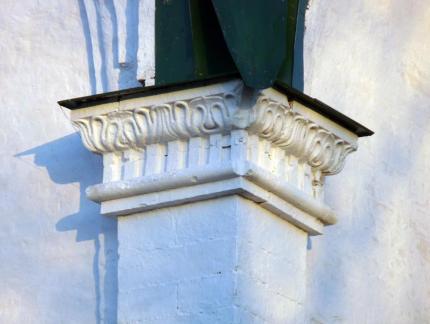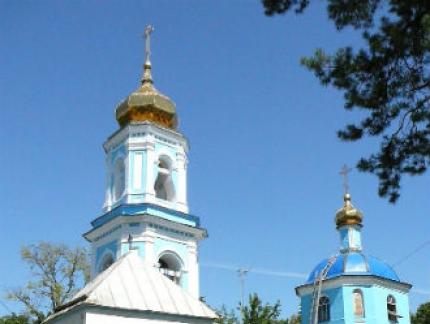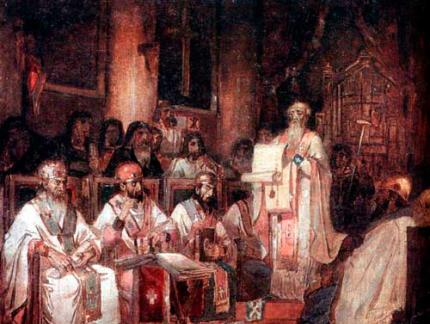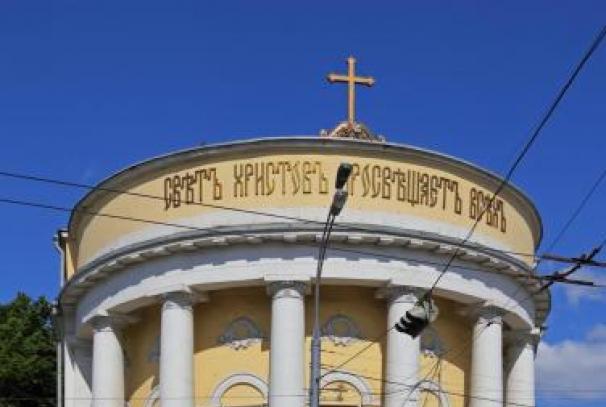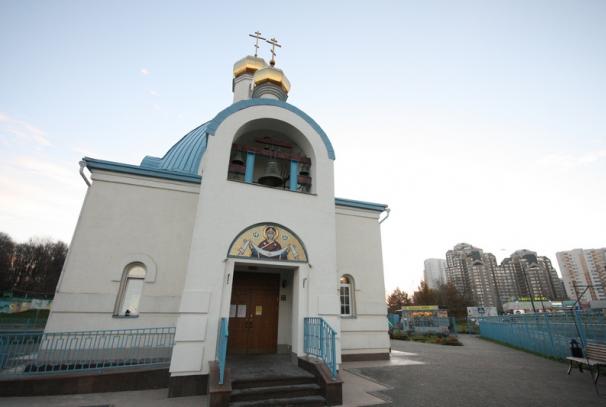Poltava diocese. Office of the Poltava Diocese of the Ukrainian Orthodox Church of the Moscow Patriarchate
In the Rivne and Volyn communities of the UOC churches under pressure, they urge the President and supporters of the "Ukrainian Orthodox Church" to stop arbitrariness (+ video)
Despite the assurances of the authorities that the seizure of churches and forced transfers of religious communities to the newly created "PCU" will cease, the parishes of the UOC in Volyn and Rivne are still exposed [...]2 months back published on the website Інформаційно -awhich is vіddіl UPTSThe activities of the “HRC” promote the service of the divine services to the Rivnensky Patriarchate and the Beaten Women (+ video)
The clergy and the clergy of the Rivne Apostolic Church of the UOC, chanted, most often in Ukraine, have the opportunity to tolerate an attack of the so-called “CCP” for the remaining hours. Tilki stretching out these vihidnih bulo vlashtovany a number of provocations [...]2 months, 2 weeks back published on the website Інформаційно -awhich is vіddіl UPTSBarbarism of officials in the Vinnitsa region: the UOC priest with his pregnant wife and young children is put out (+ documents)
On April 8, 2019, four registered messages from the local village council were received by priest Pavel Taran, rector of the Church of the UOC of the Holy Apostle Evangelist John the Theologian in the village of Krasnoselka, Bershad district of Vinnitsa [...]3 months, 3 weeks back published on the site Το Τμήμα Πληροφοριών της Ουκρανικής Ορθοδόξου ΕκκλησίαςBishop Viktor Baryshevsky reported violation of the rights of believers of the UOC at the OSCE meeting in Vienna
On April 1-2, 2019, with the blessing of His Beatitude Metropolitan Onufry of Kiev and All Ukraine, Onufry, Chairman of the Representation of the UOC at European International Organizations, Bishop Viktor Baryshevsky received [...]The European Court of Human Rights has accepted the case of the parish of the UOC c. Bird
On March 14, 2019, the European Court of Human Rights sent to the religious community of the UOC with. The birds of the Rivne region an official statement that the applicant’s complaint about the actions of the Ukrainian authorities in connection with [...]4 months back published on the site of the Synodal Information and Education Council of the UOCHis Beatitude Metropolitan Onufry: Sorrows and illnesses in our lives make up for the lack of repentance (+ video)
In his sermon on Holy Week, His Beatitude Metropolitan Onufry talked about how to tolerate sorrows and illnesses, the UOC Information and Education Department reports. The archpastor said that [...]4 months back published on the site of the Synodal Information and Education Council of the UOCBy stealing and deceiving, a person can consider himself a Christian, but this is not so - Primate (+ video)
His Beatitude Metropolitan Onufry, in his sermon on Holy Week, explained why people who do not keep the commandments of the Lord cannot call themselves Christians, informs the [...]4 months back published on the siteDue to political reasons and a number of events of the XX-XXI centuries, several Orthodox jurisdictions operate on the territory of modern Ukraine. Therefore, when describing church life in a particular diocese, it is necessary to clarify from the standpoint of which church party it is represented. In this article, we will talk about one of the oldest departments of Orthodox Russia, of which, undoubtedly, the Poltava diocese. It will be presented mainly in the person of the Moscow Patriarchate, both due to the predominant canonical position of this organization in the Orthodox world, and because of its leading position in the region.
The ancient history of Orthodoxy in the Poltava region
The well-known year 1054, in addition to what marks the great schism of the Christian church, is also interesting in that it is a reference point for the life of the Poltava diocese. It was called, however, at that time Pereyaslavskaya, and its first ruling bishop was Bishop Nikolai. A little over two hundred years after its founding, independent church rule in the Poltava region was abolished, and church structures passed directly under the omophorion. It happened in 1279.
Restoration of the department
The decision to restore the activities of the Pereyaslav diocese was made only in 1700. But even then, her status was limited by the rights of vicariousness within the framework of the Kiev Metropolis. Then its position repeatedly changed, either moving to independent management, or being territorially divided between the neighboring church centers. In the end, in 1799, by decree of Emperor Paul, Vicarism received the status of independent government with the name “Little Russian and Pereyaslavl”. However, already in 1802, in connection with the liquidation of the Little Russian province, the system of church government in the Poltava region changed: Poltava became the main cathedral center (initially only nominally due to the lack of the necessary material base for the administrative apparatus), and Pereyaslavl became the second diocesan center. The official name "Poltava and Pereyaslavl" was assigned to the diocese in 1847. In this form, it existed until 1937.
Throughout its history, the Poltava diocese had two vicarities in its composition. The first of them - Pryluksky - was formed in 1884 and lasted until the diocese was disbanded in the 30s of the XX century. The second, called Lubensky, functioned only for eight years from 1920 to 1928.

When Soviet power was established in the territory, the life of the diocese gradually began to fade. Massively closed churches and liquidated monasteries. In 1937, the ruling bishop, together with the vicar subordinate to him and all the clergy of the diocese, was repressed. After this, the temporary management of the department was taken over by Bishop Mitrofan (Rusinov), who, however, soon died. In fact, in 1939 the Poltava diocese was completely destroyed.
The revival of church life took place during the Great Patriotic War, when a number of churches were opened and some were established under the German occupation. In 1944, the department became known as Poltava and Kremenchug. In this form, it exists to this day in the framework of the Kiev Patriarchate. As for the Moscow church structures, since 2007 the diocese was renamed Poltava and Mirgorod in connection with the separation of the Kremenchug department as an independent center.

Poltava diocese of UOC MP
Within the jurisdiction of the Kiev Metropolitanate of the Moscow Patriarchate, the Poltava Chair occupies an important strategic and political position, due to its historical significance, scale and geographical position within the state.
She is in charge of a theological seminary with a missionary bias, and the primate bears the title of Metropolitan. Today it is His Eminence Philip (Osadchenko). The Poltava diocese in its jurisdiction owns two cathedrals (St. Macarius and the Resurrection of Christ) in the capital city and one (Assumption of Our Lady) in Mirgorod. There are three monasteries in the region - one male and two female. Seven diocesan departments and several auxiliary institutions, such as the youth club at the Cathedral of St. Macarius Cathedral, are engaged in ensuring fruitful interaction between society and the church on the part of the latter.

Other Orthodox jurisdictions in the Poltava region
As already mentioned, except for the UOC, the Poltava diocese belongs to a number of independent church structures. There are a lot of such independent jurisdictions in Ukraine. The smallest of them have only a few units of parishes, and the largest, such as the Kiev Patriarchate, represent a serious political force that successfully competes with the UOC-MP and even disputes its rights.
The Poltava diocese of the UOC-KP today is a vast territory, led by Archbishop Theodore (Bubnyuk). In particular, it, as already noted above, retains Kremenchug as the second cathedral city. In addition to the UOC-KP, in the territory of Poltava there are parishes and communities of various branches of the UAOC, the CPI and other independent jurisdictions of Ukrainian Orthodoxy.
This article should be vikified. Please arrange it according to the rules for writing articles ... Wikipedia
The Russian Orthodox Church includes dioceses of direct subordination in Russia, the Near Abroad, America and Europe, Chinese and Japanese autonomous Orthodox churches, self-governing Ukrainian, Moldavian, Latvian, Estonian and Russian ... ... Wikipedia
The article provides brief relevant information on the dioceses of the Russian Orthodox Church (Moscow Patriarchate). All dioceses are listed by region of their presence in alphabetical order. The titles of bishops coincide with the names of the heads they lead ... ... Wikipedia
The article provides brief relevant information about the dioceses of the Ukrainian Orthodox Church as part of the Moscow Patriarchate. See also the article of the Diocese of Ukraine. Name of the diocese. Founding Ruling Bishop Territory of the Parishes of the Monasteries of the Deaneries ... ... Wikipedia
Dioceses of the Ukrainian Orthodox Church The article provides brief relevant information on the dioceses of the Ukrainian Orthodox Church as part of the Moscow Patriarchate See also the article of the Diocese of Ukraine Name of the Diocese Founding Ruling Bishop ... ... Wikipedia
All diocesan and vicar bishops participate in the Local Council (except for those who are retired and are prohibited). In addition to them, one delegate is selected from the dioceses from the white clergy, from the monks and from the laity. The total number ... ... Wikipedia
This page is an information list. See also main article: Moscow ... Wikipedia
POLTAVIAN DIOCESE
Open Orthodox Encyclopedia "TREE".
Poltava and Mirgorod diocese of the Ukrainian Orthodox Church.
Diocesan Administration: Ukraine, 36024, Poltava, st. Roses Luxembourg, 62-a
Phone: (10 380 53-22) 7-90-88
Official website: http://www.pravoslavie.poltava.ua/
As part of the Pereyaslav and Kiev departments
Soon after the establishment of Orthodoxy in Russia, the lands of the modern Poltava region became part of the Russian state, and were part of the Pereyaslav diocese, which lasted until the second half of the 13th century. After its abolition, this territory was probably under the direct control of the Kiev sovereigns until the resumption of the Pereyaslavsky pulpit at the turn of the XVII - XVIII centuries, where it again moved.
In 1775, part of the Poltava lands also entered the newly created Slavic diocese, uniting the entire vast New Russia, which was annexed shortly before to the Russian Empire. The department of the new diocese, renamed Yekaterinoslavskaya in 1786, was located until 1797 in Poltava, in the Holy Cross Monastery.
According to the Highest Decree of October 16, 1799 on bringing the diocesan and provincial borders into conformity, the Pereyaslav department again regains independence under the name of the Little Russian and Pereyaslav regions and occupies the territory of the Little Russian province created in 1796, which includes the whole Poltava region.
Poltava diocese in the synodal period
However, soon the provincial system was replaced again, and already on December 4 or 17, 1803, the Little Russian Diocese was transformed by the decree of the Holy Synod of Poltava. At the same time, the residence of the hierarchs of the new Poltava diocese, inheriting the Little Russia, remained for a long time in the city of Pereyaslavl, in the suburban cottage of Andrusha, due to the lack of suitable premises for the diocesan administration in Poltava. Only in 1847 the center of the diocese was moved to Poltava.
To help manage the diocese in 1884, the Priluk Vicariate was opened, whose bishops stayed at the Poltava Holy Cross Monastery, the former residence of the Ekaterinoslav bishops.
In 1863 - 1919 the diocese had its own press organ - the Poltava Diocesan Gazette journal. At different times, in addition to the modern Poltava region, the territory of the Poltava diocese also included Pereyaslavsky, Zolotonoshsky, Pryluksky and Romensky districts (now - Kiev, Cherkasy, Sumy and Chernihiv regions). From 1890 to 1918, the Poltava Diocesan Brotherhood in the name of the Holy Martyr Makarii acted, helping the parish schools. Thanks to the active work of the ruling bishop John (Smirnov) and a number of famous Poltava scholars, the Poltava Archaeological Committee and the Poltava archaeological store were created in 1906 under the decree of the Holy Synod, a unique museum of rare church antiquity, which preserved the Peresopnitsky Gospel, which operated until 1919 of the year.
Revolutionary hard times, persecution, war
With the establishment of Soviet power, church property, including sacred objects, was looted or seized by order of the authorities. Then they were transferred to the state museums and treasures of the Poltava ancient storage. After the closing of the Poltava Holy Cross Monastery in 1923, the imperishable remains of Archbishop Ambrose (Serebrennikov), as well as Athanasius (Volkhovsky), Bishop of Mogilev disappeared without a trace.
After the events of October 1917, churches and monasteries in the Poltava region began to close in a mass fashion; in 1937, the entire ruling diocesan episcopate, along with the clergy, was repressed, parishes liquidated. In 1939, after the death of the temporarily managing diocese of Bishop Mitrofan (Rusinov), the department in Poltava was practically nipped.
During the Nazi occupation, in 1942 - 1943, the Poltava diocese resumed its activities for a while, some of the churches were opened. The ruling bishop bore the title "Poltava and Lubensky". Archpriest Vladimir Binevsky led the diocese before the appointment of the bishop - Bishop Benjamin (Novitsky).
In the post-war USSR
In the postwar years, the Poltava diocese suffered as much as the whole Church. The number of active parishes decreased from 346 in 1945 to 52 in 1970, clergy - from 376 to 65. The figures for the 1970s remained approximately unchanged until the 1988 turning point.
Modern stage
With the fall of the atheistic regime in the Poltava diocese, as well as throughout the Church, the process of restoring church life, returning people to faith and rebuilding churches quickly began.
Today, the diocese unites parishes and monasteries in the eastern part of the Poltava region, which includes Velikobagachansky, Gadyachsky, Dikansky, Zenkovsky, Karlovsky, Kobelyaksky, Kotelevsky, Mashevsky, Mirgorodsky, Novosanzharsky, Poltava, Reshetilovsky, Chutovsky and Shisha. Cathedral City - Poltava. Cathedral - Makarievsky (Poltava).
Name changes
Poltava and Lubenskaya 1942 - 1943
Poltava and Kremenchug 1944-14.XI. 2007
Poltava and Mirgorod from 14.XI. 2007
Statistics
1912 - 2606899 people of the Orthodox faith, 1250 temples, 7 monasteries (3 men, 4 women) with almost 500 monks and nuns and with as many novices and novices, four theological schools (in Poltava, Lubny, Pereyaslav and Romny), spiritual a seminary and a female diocesan school in Poltava, almost every church had a parish school or a literacy school in which more than 54,000 pupils and pupils studied. In 17 cathedrals, 1124 parish churches, 29 ascribed, 22 house and 40 cemetery churches, 51 archpriests, 1262 priests and 1386 psalm-worshipers obeyed.
1912 - churches - 1256, chapels - 31; monasteries - 8 (3 men., 5 women.); theological seminary - 1, theological schools - 4, the diocesan female school - 1, the church school - 1051; libraries attached to churches - 1241.
1945 - 346 churches, 376 clergymen (including 5 monks).
1948 - 340 churches, 325 clergymen (level preserved until 1961).
1970 - 52 churches, 65 clergymen.
beg. 1988 - almost the same as in 1970, slightly more clergy.
oK. 2004 - 358 parishes; 231 clergymen (214 priests, 17 deacons).
Archpastors
Parthenius (Levitsky) (1920 - 1921) high school, archbishop. b. Tula (at rest)
1921-1923 - widowhood of the department
1939-1942 - almost stopped
Simon (Ivanovsky) (1945 - 1947)
Alipiy (Khotovitsky) (June 15, 1958 - August 14, 1961, November 14, 1961 - March 30, 1964) for the first time - w / u, Kremenchug
Vicar dioceses
Prylukskaya (invalid)
Lubenskaya (invalid)
Priyatinskaya (invalid)
Kobelyakskaya (invalid)
Romenskaya (invalid)
Pereyaslavskaya (invalid)
Khorolskaya (invalid)
Diocesan Departments
on cooperation with the Armed Forces, law enforcement agencies and ITU
Monasteries
Monastery in honor of the Exaltation of the Holy Cross in Poltava (female)
Schools
Poltava Missionary Theological College
Orthodox associations and organizations
Orthodox Brotherhood "Union of Orthodox Believers in Honor of the Gorbanev Icon of the Mother of God", Poltava
Orthodox youth fraternity in honor of the Kozelshchansk Icon of the Mother of God, town. Vault of Zenkovsky district
Diocesan Brotherhood named after the Holy Martyr Macarius (1890 - 1918)
Church Media
The Poltava Eparchial Vedomosti (1863 - 1919), now the Vidomosti of the Poltava Eparchy (since January 2002)
Blagovest, Orthodox youth fraternity in honor of the Kozelshchansk Icon of the Mother of God
“Glory to God for everything”, Charles deanery
“Transfiguration”, Poltava Spassky Church
"Ladanka", Trinity community p. Takhtaulova
Literature
Kolomensky, G., Collection of necessary information about each parish and the calendar address of the clergy of the Poltava diocese: part 1, Poltava, 1890, 309 p.
Reference Clear Book on the Poltava Diocese for 1912, Poltava, 1912,, XCII, 303 pp.
Pavlovsky, I.F., Poltava: Hierarchs, statesmen and public figures and philanthropists: The experience of a brief biographical dictionary of the Poltava province from the middle of the 18th century , Poltava, 1914, XVI, 294 p., 182 l. Portr.
Used materials
Article of the Russian Orthodox Church 2000-2004:
http://ezh.sedmitza.ru/index.html?did\u003d125
Historical sketch on the official website of the diocese:
http://pravoslavie.poltava.ua/ru/0/1136543104/view.php
http://mospat.ru/index.php?chp\u003d_eparchies&cid\u003d101
http://hierarchy.religare.ru/h-orthod-russian-poltava.html
Or until 1799 - see http://pravoslavie.poltava.ua/ru/0/1136543104/view.php
Date by Yu. Tolstoy, 121; . According to Durnovo N.N. - 4.XII. 1803. See http://ortho-rus.ru/cgi-bin/or_file.cgi?3_866
The date for the historical sketch on the official website of the diocese is http://pravoslavie.poltava.ua/ru/0/1136543104/view.php. According to http://ortho-rus.ru/cgi-bin/or_file.cgi?3_866 - until 1928.
According to the clergy book of the Poltava diocese. Cit. according to the historical outline on the official website of the diocese http://pravoslavie.poltava.ua/ru/0/1136543104/view.php
Http://ortho-rus.ru/cgi-bin/or_file.cgi?3_866
According to the historical outline on the official website of the diocese http://pravoslavie.poltava.ua/ru/0/1136543104/view.php
According to the historical outline on the official website of the diocese http://pravoslavie.poltava.ua/ru/0/1136543104/view.php
According to the historical outline on the official website of the diocese http://pravoslavie.poltava.ua/ru/0/1136543104/view.php
According to the historical outline on the official website of the diocese http://pravoslavie.poltava.ua/ru/0/1136543104/view.php
According to the historical outline on the official website of the diocese http://pravoslavie.poltava.ua/ru/0/1136543104/view.php
According to the article of the ROC 2000-2004 Guide, http://ezh.sedmitza.ru/index.html?did\u003d125
So according to http://hierarchy.religare.ru/h-orthod-russian-poltava.html. According to other sources - from January 15. See http://ortho-rus.ru/cgi-bin/or_file.cgi?3_866
So according to http://hierarchy.religare.ru/h-orthod-russian-poltava.html. According to other sources - from June 29. See http://ortho-rus.ru/cgi-bin/or_file.cgi?3_866
In connection with a long illness, the archbishop. John
So for MMR "RPI" (762), for http://hierarchy.religare.ru/h-orthod-russian-poltava.html. According to http://ortho-rus.ru/cgi-bin/or_file.cgi?3_866 - until February 21.
So according to http://ortho-rus.ru/cgi-bin/or_file.cgi?3_866. Bishop John (Snychev) ("Composition of the Russian ... hierarchy for 1971"), http://hierarchy.religare.ru/h-orthod-russian-poltava.html - indicate him as the ruling bishop both times.
In the article of the ROC 2000-2004 Guidebook - it was erroneously indicated until October 7, 2001. See http://ezh.sedmitza.ru/index.html?did\u003d125. According to http://ortho-rus.ru/cgi-bin/or_file.cgi?3_866 - for the first time until September 12, 1979.
So according to http://hierarchy.religare.ru/h-orthod-russian-poltava.html. By http://ortho-rus.ru/cgi-bin/or_file.cgi?3_866 - until April 19, 1985.
So according to http://hierarchy.religare.ru/h-orthod-russian-poltava.html. By http://ortho-rus.ru/cgi-bin/or_file.cgi?3_866 - until May 15, 1992.
DREVO - open Orthodox encyclopedia: http://drevo.pravbeseda.ru
About the project | Timeline | Calendar | Client
Orthodox Encyclopedia Tree. 2012
See also the interpretations, synonyms, meanings of the word and what the POLTAVIAN DIOCESE in Russian is in dictionaries, encyclopedias and reference books:
- POLTAVA in the Directory of Settlements and Postal Codes of Russia:
353800, Krasnodar, ... - DIOCESE in the Dictionary of Church Terms:
(Greek region) - a church-administrative unit, governed by a bishop. Dioceses are divided into deaneries consisting of several parishes. The boundaries of dioceses, as a rule, are ... - DIOCESE
Open Orthodox Encyclopedia "TREE". Diocese (Greek region) is a church-administrative unit. Dioceses are divided into deaneries, consisting of several parishes ... - DIOCESE in the Big Encyclopedic Dictionary:
(Greek eparchia) in the Orthodox churches, a church-administrative territorial unit led by a bishop ... - DIOCESE in the Great Soviet Encyclopedia, TSB:
(Greek eparchia), a church-administrative territorial unit in the Orthodox, Catholic, Anglican churches, led by a bishop. In Kievan Rus, the division into E. was carried out ... - POLTAVA
Poltava battle. - In the spring of 1709, during the Northern War, the Swedish king Charles XII, being in an extremely difficult situation, decided to plant Poltava, ... - DIOCESE in the Encyclopedic Dictionary of Brockhaus and Euphron:
the name of the unit of the civil administrative unit in the Greco-Roman Empire. Constantine the Great divided the empire into four prefectures, of which each was divided into several ... - DIOCESE in the Encyclopedic Dictionary:
and, w. In the Orthodox Church: a district ruled by a bishop. Diocesan - referring to the diocese, dioceses. This is not my diocese (deb.) - ... - DIOCESE in the Encyclopedic Dictionary:
, and, well. Church-administrative territorial unit, managed by the bishop. * This is already in another diocese (open) - in someone’s other jurisdictions ... - DIOCESE in the Big Russian Encyclopedic Dictionary:
EPARCHIA (Greek eparchia - rule, rule), in the right. churches church-adm. Terr. unit led by a bishop (bishop, archbishop, ... - DIOCESE in the Encyclopedia of Brockhaus and Efron:
? the name of the unit of the civil administrative unit in the Greco-Roman Empire. Constantine the Great divided the empire into four prefectures, of which each was divided into ... - DIOCESE in the Full Accentuated Zalizniak Paradigm:
epa "rhia, epa" rhii, epa "rhii, epa" rhiy, epa "rhii, epa" rhiyam, epa "rhiyu, epa" rkhii, epa "rkhiya, epa" rkhiyu, epa "rkhiy, epa" rhii - DIOCESE in the Popular explanatory-encyclopedic dictionary of the Russian language:
-and, w. In the Orthodox Church: a district ruled by a bishop (bishop). [Papa] Adrian II, trying to keep the Moravian lands under his control, created ... - DIOCESE in the New Dictionary of Foreign Words:
(gr. eparchia) church-administrative territorial ... - DIOCESE in the Dictionary of Foreign Expressions:
[column eparchia] church-administrative territorial ... - DIOCESE in the New Explanatory Dictionary of the Russian Language Efremova:
g. 1) Church-administrative territorial unit; county governed by the bishop. 2) trans. unleash Field of activity located in ... - DIOCESE in the Russian Language Dictionary Lopatin:
eparchy, ... - DIOCESE in the Complete Spelling Dictionary of the Russian Language:
diocese, ... - DIOCESE in the Spelling Dictionary:
eparchy, ... - DIOCESE in the Russian Language Dictionary Ozhegova:
church-administrative territorial unit, managed by the bishop This is not my e. (trans.: not my area, not in my jurisdiction; decomp ... - DIOCESE in the Dahl Dictionary:
wives , Greek. general area under the control of the diocese husband. ruler; now a region, a region governed by spiritual affairs by the bishop; his department. ... - DIOCESE in the Modern Explanatory Dictionary, TSB:
(Greek eparchia), in the Orthodox churches a church-administrative territorial unit led by a bishop ... - DIOCESE in the Explanatory Dictionary of the Russian language of Ushakov:
dioceses, w. (Greek eparchia) (church official). Church administrative unit; county governed by ... - DIOCESE in the Explanatory Dictionary of Ephraim:
diocese 1) Church-administrative territorial unit; county governed by the bishop. 2) trans. unleash Field of activity located in ... - DIOCESE in the New Russian Language Dictionary Efremova:
g. 1. Church-administrative territorial unit; county governed by the bishop. 2. trans. unleash A field of activity located in someone else’s ... - DIOCESE in the Big Modern Explanatory Dictionary of the Russian Language:
I g. Church-administrative territorial unit, managed by the bishop; district (in the Orthodox Church). II g. unleash Sphere or place ... - TUROVSK DIOCESE in the Orthodox Encyclopedia Tree:
Open Orthodox Encyclopedia "TREE". Turov and Mozyr diocese of the Belarusian Exarchate of the Russian Orthodox Church. Diocesan Administration Address: Belarus, 247760, ... - TOBOLSK DIOCESE in the Orthodox Encyclopedia Tree:
Open Orthodox Encyclopedia "TREE". Tobolsk and Tyumen diocese of the Russian Orthodox Church Diocesan administration: Russia, 626100, Tobolsk, Tyumen ... - ODESSA DIOCESE in the Orthodox Encyclopedia Tree:
Open Orthodox Encyclopedia "TREE". Odessa and Izmail diocese of the Ukrainian Orthodox Church. Diocesan Administration: Ukraine, 65023, Odessa, ... - LUTSK DIOCESE in the Orthodox Encyclopedia Tree:
Open Orthodox Encyclopedia "TREE". Lutsk and Volyn Diocese of the Ukrainian Orthodox Church Diocesan Administration: Ukraine, 43016, Volyn Region, Lutsk ... - KIEV DIOCESE in the Orthodox Encyclopedia Tree:
Open Orthodox Encyclopedia "TREE". Diocese of Kiev, Ukrainian Orthodox Church Diocesan Administration: Ukraine, 01015, Kiev, st. January Uprising, 25, ... - BELGOROD DIOCESE in the Orthodox Encyclopedia Tree:
Open Orthodox Encyclopedia "TREE". Belgorod and Stary Oskol diocese of the Russian Orthodox Church. Address: Russia, 308000, Belgorod, ul. ... - ALASKIAN DIOCESE in the Orthodox Encyclopedia Tree:
Open Orthodox Encyclopedia "TREE". The Sitka, Anchorage, and Alaskan Diocese of the Orthodox Church in America. Diocesan Office: PO Box 210569, Anchorage ... - POLTAVA, PAGE in the Encyclopedic Dictionary of Brockhaus and Euphron:
art. Temryuk Department Cube reg. Living 4000; 2 schools; several creameries, leather and coopers ... - POLTAVA PROVINCE in the Encyclopedic Dictionary of Brockhaus and Euphron:
I lies between 51 ° 8 "and 48 ° 41" s. w. and between 31 ° 2 "and 36 ° 3" in. d. (from Greenwich). From the southwest and ... - POLTAVA BATTLE in the Encyclopedic Dictionary of Brockhaus and Euphron:
In the spring of 1709, during the Northern War, the Swedish king Charles XII, being in an extremely difficult situation, decided to besiege Poltava, in ...
The clergy of the Poltava diocese unanimously supported the preservation of the existing status of the UOC and expressed support for Metropolitan Onufry
The Fifth Column in the Russian Orthodox Church: Who is trying to force the Orthodox to surrender to the schismatics? Interfax reported this on October 25, citing the press service of the religious organization. It should be noted that support of the head of the canonical UOC was announced in the clergy of the Dnipropetrovsk region, Zaporizhzhya, Odessa, Kherson and Rivne dioceses, as well as the Metropolitan of Kirovograd Joasaph.
“Meanwhile, the head of the Department of Religious Affairs of the Ministry of Culture of Ukraine Andrey Yurash stated that more than 50% of the UOC communities will go to the new church created by Constantinople, ”the statement said.
As Ukrainian.ru reported, the head of the unrecognized Kiev Patriarchate Filaret (Denisenko)he said that the idea of \u200b\u200bautocephaly has support in the Ukrainian Church of the Moscow Patriarchate. He specified that ten bishops of the UOC-MP are ready to sign an appeal to the Ecumenical Patriarch Bartholomew asking for the gift of tomos. At the same time, disclose their names, citing Moscow's threats against them.
In turn, the head of the synodal department of the Russian Orthodox Church on church relations with society and the media Vladimir Legoyda, denied information about the widespread support for autocephaly among the clergy of the UOC, as evidenced by data from open and closed polls.
Moreover, even Metropolitan Cherkassky Sofroniy of the canonical UOC, known for its open calls for autocephaly, said it refuses to be in the same religious organization with the head of the unrecognized Filaret.
Orthodoxy in modern Ukraine. Help Recall the President of Ukraine Petro Poroshenko appealed to the Patriarch of Constantinople with an appeal to publish a tomos about a single local Orthodox church in Ukraine. For these purposes, Patriarch Bartholomew appointed Archbishop of Pamphylia as his exarchs in Kiev Daniel from the USA and the bishop of Edmont Hilarion from Canada.
On October 17, the exarchs announced that they were working on the last stage of the unification Council before providing a tomos of autocephaly. At the same time, they expressed hope for cooperation with all the clergy of the Ukrainian Orthodox Autocephalous Church, as well as the Kiev and Moscow Patriarchates.
At the same time, a political scientist Kirill Molchanov believes that the unification Council of the UOC-KP and UAOC may not take place. The relationship of their heads, Filaret and Macaria so conflicted that, according to the expert, even it would be problematic to collect them, not to mention the UOC, which did not ask for autocephaly at all.

